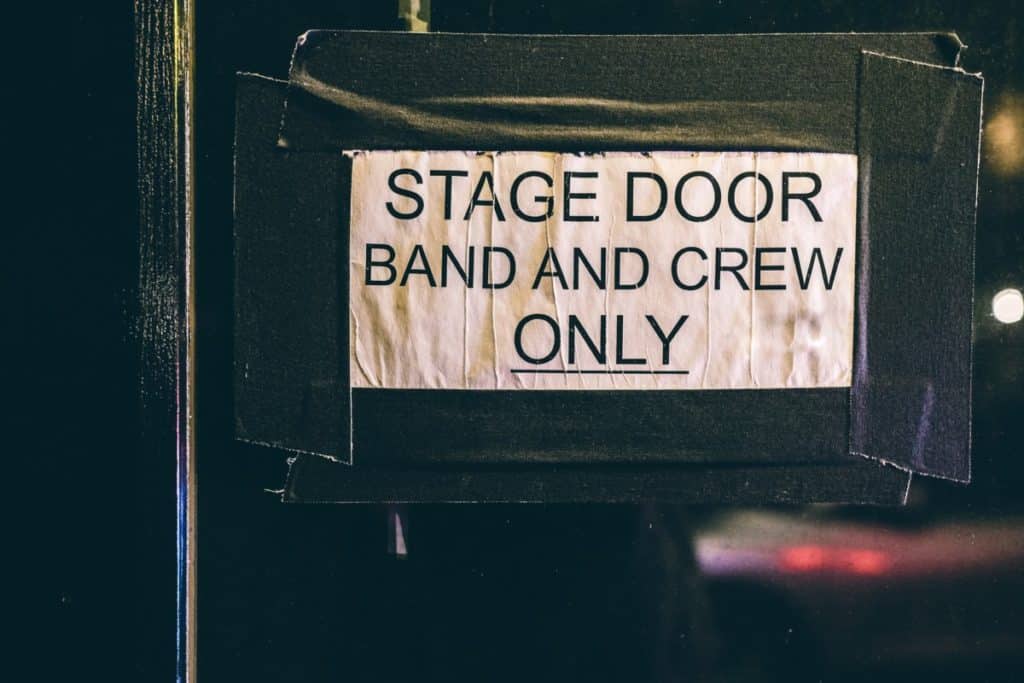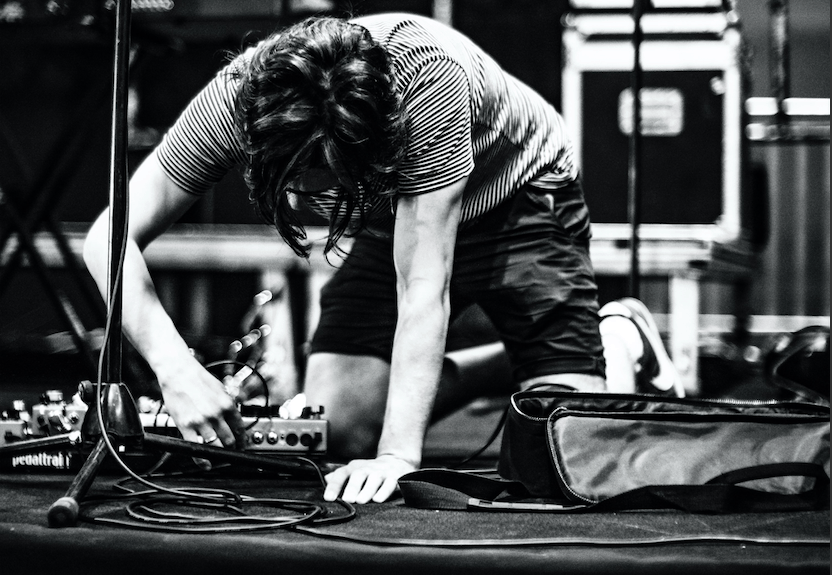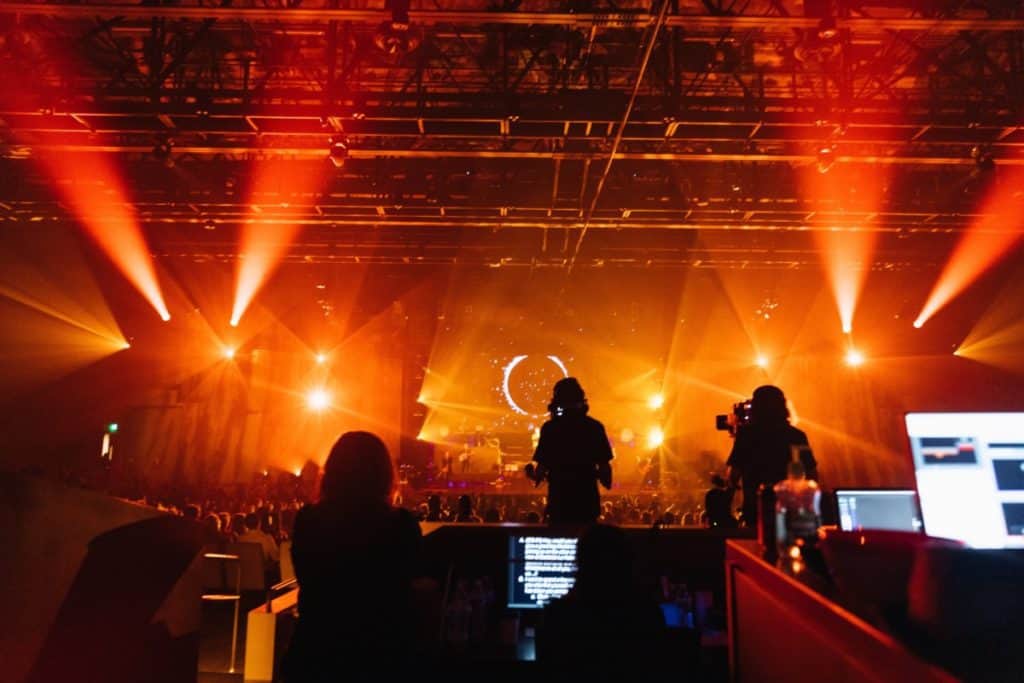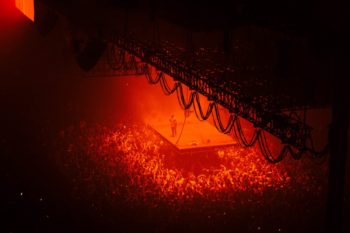
Here’s a fun fact: setting up a concert stage takes a lot of work. Every band and crew knows what it takes to set up their gear, run lights, test sound, and then double-check it all again (just to be safe). But the average person might be surprised to learn how long it takes, from start to finish.
How long does it take to set up a stage for a concert? About 12 hours. However, the length of time required to set up a concert stage depends on the size of the production. Seasoned bands on club tours can set up, check lights and test sound in less than 1 hour. Larger productions, like stadium tours, take between 12 and 15 hours to completely set up.
Imagine how many people it takes to put together a production for a major pop artist like Twenty One Pilots or Imagine Dragons.
It easily requires a crew of 30-50 technicians to set up LED screens, strobe lights, smoke-makers, flamethrowers, soundboards, stage props, crowd barriers, merch displays and then go figure out everything else that’s going on backstage.
In comparison, smaller touring artists usually only have a handful of people to help with stage set-up, and independent artists usually are forced to do everything themselves.
The amount of time it takes to set up a stage depends on multiple factors, including the size of the venue, the complexity of the production, and the number of people in your road crew. Keep reading if you’d like to find out why.
Load-In, Load-Out

The first step to every concert set-up is compartmentalizing all of the gear that a band needs — understanding what’s important, breaking it down, and loading it all into a van or trailer.
Packing up the instruments alone is a tedious and time-consuming process that requires careful attention to detail.
If you’ve ever broken-down or set-up a drum kit, you know that there are multiple screws, bolts, cymbals, and stands that need to be individually packed away.
If you forget something, it’s likely that the kit won’t work the way it’s supposed to. For the show to go on you’ll have to make an emergency trip to Guitar Center (or a local music shop) to replace the forgotten piece or part.
For touring bands, that extends beyond just drum kits.
There are countless wires, power strips, effects pedals, amplifiers, guitars, microphones, speakers, in-ear monitors, and dozens of other instruments (like keyboards), that need to be safely packed in road cases to avoid damage or loss in transition.
But that’s just considering traditional instrument driven bands, with minimal focus on how a live performance might look, or feel.
Performers with any sort of production element to their live-show need to bring along turntables, mixers, sample pads, signal processors, computers, banners, lights, fog machines, projectors, and any number of other tour accessories to ensure that their performance sounds, looks, and feels exactly the way that they intend it to.
Once everything is broken down, loading all of that gear into a van or trailer, so it can be transported from city to city, takes someone with serious Tetris skills.
The larger the performance, the more travel space artists need in order to transport every aspect of their live show.
Ultimately, before anyone has even begun setting up the actual stage, whether it’s a large or small venue, there’s already been a tremendous amount of time and physical labor spent on just getting things ready to be set up.
After everything has been carefully accounted for and packed away, it then has to be transported to the designated location.
But before anyone can actually start setting things up, it all has to be unloaded from the van or trailer into the venue within a very specific window (or load time) usually designated by the venue or promoter before the show.
When the stars finally align — everything and everyone is where they’re supposed to be, when they’re supposed to be there — it’s time to start getting things set up.
Setting Up The Stage

When it’s finally time to start setting up, all of the essential gear needs to be shuttled from the van to the venue.
On most tours, multiple bands will need to unload their gear and go through the process of setting up, checking equipment, and running sound.
When everyone is done, everything else can go on as planned — merch displays can be set up, excess gear or equipment can be loaded back into the van, the bands can leave to find something to eat, etc.
This is why most venues will schedule load times for the performing bands.
If every performer on the bill tried to load-in and set-up at the same time, it would be a disaster.
Or, if nobody showed up until an hour before the show no one would be able to get their equipment set up before the venue would need to open the doors.
A typical load schedule on a club tour with 3 bands, where doors open at 8 PM, might look something like this:
~~ LOAD SCHEDULE ~~
1:00-3:00 PM — HEADLINE BAND
(2 Hours)
3:15-4:45 PM — SUPPORT BAND
(1.5 Hours)
5:00-6:00 PM — OPENING BAND
(1 Hour)
Of course, each band is responsible for their own equipment and rarely is any gear shared between bands.
Unless mutually agreed upon before the tour starts, each band will have its own drum kit, guitars, amps and any number of other bells and whistles.
This means that all of the equipment for the evening either needs to be loaded onto the stage in layers — ready to be quickly stripped off the stage as each band exits after their performance — or everything needs to be waiting backstage where it can be quickly loaded on and then subsequentially loaded back off as each band performs.
In situations where there isn’t a road crew to help shuttle gear from backstage, or there isn’t a backstage to begin with, the layers option is often the default to minimize transition times between sets.
In these scenarios, usually, the headlining band gets the highest priority load time and most ideal positioning on stage. This gives them the most room and attention possible, to ensure that their performance sounds and looks exactly how it’s supposed to.
Unfortunately, this means the support bands have to set their gear up in front of the headliner’s, leaving less room on the stage to move around and perform.
Also, this sometimes means the supporting bands’ time to set up and check sound can be cut in order to accommodate the headliner.
It’s not always intentional, sometimes accidents happen, but it still sucks when you’re an opening band and you only have 15 minutes to set up and check sound.
Of course, sometimes the opposite can also happen, when the headliner will finish setting up and checking sound in record time, leaving extra time for the other bands.
Depending on the bands you’re touring with it can be a coin toss from night-to-night — welcome to show business, baby.
Soundcheck

Soundcheck is arguably the most important aspect of setting up a concert.
What is a soundcheck at a concert? Soundcheck is the process of testing the venue’s monitoring system, before the concert begins, to ensure that the sound levels coming from the stage aren’t too loud, soft, or unbalanced during the performance.
Typically, a soundcheck process will be facilitated by a sound engineer who will run through a series of individual checks with the band, making sure that drums, guitar, bass, vocals, etc. can each be heard through the Public Address monitors (or PA system).
After initial checks are finished, the engineer may ask the band to perform a small portion of their show to make sure everything sounds balanced and smooth (ie. the drums aren’t drowning out the vocals, or the guitar isn’t screechingly loud and harsh).
Depending on how familiar the engineer is with the band and how much equipment actually needs to be individually checked, the soundcheck process can be fairly straightforward (15-30 minutes) or drawn-out and complicated (1-2 hours).
In most cases, the stage is the loudest place in the venue, so the band will often ask to have certain adjustments made to the monitor levels being reflected back to them on stage.
For example, if the vocalist is having a difficult time hearing him or herself, they might ask to hear more vocals in the monitor directly in front of their position on stage.
Or, the drummer, usually positioned on a riser (or tucked somewhere in the back of the stage), might ask to hear more of the other instruments, since the amps are usually placed parallel to the drummer, facing outward, away from the band.
The more elements there are to a live performance, the more difficult it becomes to balance each aspect of the show’s sound, especially when everyone in the audience expects to hear the same mix no matter where they are in the venue.
This can make the process of checking sound extremely complicated.
That’s why if you’ve ever seen a band perform at a high school talent show (or a local battle of the bands), you’re probably guilty of having the harsh but common thought, “Wow… this band/singer/group sounds terrible.”
But, all things considered, those types of performances rarely (if ever) have an educated technician in charge of sound, or an adequate amount of time dedicated to each performer before they’re asked to take the stage.
It’s a bit like asking a basketball player to shoot free throws with a blindfold on — they might make one or two lucky baskets, but they’re doing everything from muscle memory.
The same goes for performers that can’t hear themselves — without a proper soundcheck, performances are almost always riddled with technical issues and sound failures.
Not to mention, the changes in volume from one performer to the next are often so extreme it’d be difficult for any audience member to sit through without cringing at some point.
Running Lights & Visuals

Running lights and visuals is the last main step to setting up a concert stage, and it’s one that most bands don’t even think about.
For a lot of artists, concerts are just about the music — it’s exclusively about playing, sounding and performing the best that they can.
Once soundcheck is over, the concert set up process is done for most bands.
Maybe they’ll hang banners or a flag on stage to let people know who they are but lights and any other visuals are typically left up to the venue to control (if there even are any).
Personally, I would say that most bands fall into that we-don’t-need-any-extra-visuals category.
The visual element of most bands’ shows doesn’t usually extend beyond stage presence — focusing entirely on delivering high energy, deeply interactive performance from the actual band members.
Maybe they include a choreographed dance move or a synchronized headbang, or one of the band members dives off an amplifier into the audience, but usually, that’s all there is.
It’s less frequent that bands stop to think about how a show looks and feels for the audience, apposed to just how it sounds.
Synchronized lights, projections, pyrotechnics, and other visual elements have traditionally been associated with larger global touring acts and festivals.
Why? Because of money and the assumption that it costs thousands of dollars to organize a visually exciting and stimulating performance.
Or because that’s the way bands have performed for a hundred years and most bands just think that’s enough.
But synchronizing a light show with backing tracks or your performance at a gig isn’t especially complicated and doesn’t need to cost an arm and a leg.
All you really need is a computer with a DAW (digital audio workstation), a DMX interface, and a couple of simple LED light bars.
There are dozens of YouTube videos like this one that can show you exactly how to set up your light show.
The process of synchronizing everything together might be a little time consuming at first, but once you have everything dialed in at home, getting it set up becomes as simple as just plugging it back in again at the venue.
Related Questions
How long does it take to clean up a concert? Cleaning up a concert typically only takes an hour or two. Once everything on stage is broken down and hauled away, all that’s left to do is mop up any spills or wet spots that could damage the stage and turn out the lights. If you’ve rented a large portable pop-up stage it might take a little longer to break down the actual stage equipment, but with a crew of 3 or 4 extra hands, the process of cleaning up and packing everything away can be done fairly quickly.
How many people does it take to put on a concert? For large scale concerts, it easily requires a crew of 30-50 technicians to set up LED screens, strobe lights, smoke-makers, flamethrowers, soundboards, stage props, crowd barriers, merch displays and everything else that’s going on backstage. In comparison, smaller touring artists usually only have a handful of people to help with stage set-up, and independent artists usually are forced to do everything themselves.
How much does it cost to build a concert stage? For a complete concert stage setup, you can expect to spend anywhere between $500 and $5000. The cost of a concert stage will vary depending on if you’re planning to rent or buy the stage, how large you want that stage to be, and what kind of accessories you’ll need (like sound and lights).
For more industry tips and music marketing hacks, check out Ennui Magazine. You can also follow us on Facebook, Twitter, Instagram, Pinterest, and YouTube.
